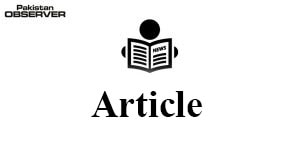Issues with educational assessment in Pakistan
Assessment is a vital element of learning process. Without it, education will not be that meaningful. It is a path between teacher’s instruction and student’s learning.
The assessment system in secondary and higher secondary schools in Pakistan is facing many challenges that need to be understood and addressed for better learning outcomes. The assessment is of two kinds, formative and summative.
The formative assessment refers to giving feedback on the performance of students, whereas the latter one implies evaluation of the performance of students at the end of given assignment.
The practice of assessment has mainly dual purpose; one is to gauge knowledge, understanding, and learning, whereas the other one is to provide basis for ranking of students. This ranking is especially used for sorting students for higher level studies
In secondary and higher secondary schools in Pakistan, the assessment of students learning is not without shortcomings.
The issue with the assessment system is that it focuses on textbooks rather than real life experiences. Also there is the absence of any kind of feedback on the part of teachers for students after they have been tested.
The students complete the required assessment process, but after being assessed, they don’t get any feedback from their teachers. Additionally, the examination papers do not meet the aspects of the objectives of curriculum.
These papers are only meant for testing content knowledge of students. The objectives of curriculum are mostly overlooked.
Besides teachers are not trained enough for the purpose of assessment. Every teacher assesses on its own discretion without having or caring for any proper benchmark.
Teachers check the answer copies and grant marks on the basis of their self-made criteria. In board exams teachers are paid incentives according to the number of answer copies they have checked.
Hence, more of teachers’ mind, instead of paying heed to the content of answers, is focused on checking more and more copies so that they could get colossal amount of stipend. This is contrary to the spirit of assessment .
The educational institutions mostly lack proper training on assessment techniques, technology and methods that need to be given to their teachers and examiners.
Another flaw in the examination system in Pakistan is that teachers are mostly unable to know about creativity and skills of students.
The rote learning methods prevalent here hinder advancement of intellectual and creative capacity of students.
The classroom learning and set examination papers both promote rote learning. Students are unaware of the benchmark of assessment. They mostly do not know the criteria on the basis of which their work is evaluated. They are on the pity of assessors.
The classroom assessment is rare in Pakistan. Most of public schools here do not have periodic activities of assessing the performance of students through different tests, or assignments.
They just focus on preparing students for annual exams, the credibility of which is not without doubt. The major cause of inadequate focus on classroom assessment is overcrowded classrooms.
In most of the public schools especially in the province of Sindh, classrooms have more than 100 students.
With such a student strength in classrooms, it becomes difficult for teachers to ensure the evaluation of the performance of students. Besides, the huge syllabus does not allow time for assessment.
Teachers remain focused on completing the syllabus to please the school administration, and are unable to spare time for assessment given the huge syllabus.
There is need of taking some drastic measures on the part of federal and provincial governments for providing standardised examination system in the educational boards.
Specific stress should be on giving such assignments in classrooms and giving such questions in exam papers that trigger creative thinking, not rote learning, in students.
Teachers should be trained regarding assessment methods. The curriculum objectives needed to be attached importance, when it comes to setting question papers.
Also, the students should be fully aware of the criteria on the basis of which there assignment would be assessed.
The syllabus should be shortened so that teachers could reserve enough time for assessing performance of students in classrooms.
There is also need of reducing the number of students in classrooms. Instead of 100-plus students, maximum 40 students per class seems an appropriate number for creation of conducive environment for learning.
To conclude, the secondary and higher secondary education in Pakistan faces assessment issues. The resolution of these assessment issues is necessary in order to ensure existence of qualitative educational system in the country.
—The writer is an independent educational researcher. based in Larkana.










